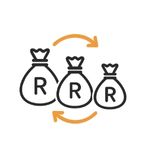
When applying for a personal loan in South Africa, many people focus mainly on the interest rate and monthly instalment. However, there are other charges that affect the total cost of the loan, and one of these is the admin fee. This fee is usually charged by lenders to cover the ongoing administrative work involved in managing your loan account. It is added either as a fixed monthly fee or included in your loan repayment plan, and can make a noticeable difference to how much you end up paying over time.
Key Takeaways
- Admin Fees Are Separate from Interest and Initiation Charges: These monthly fees cover the operational costs of managing a loan and are not part of the interest or once-off initiation fee. Over time, they can add up and significantly increase the total amount repaid.
- Regulated but Varying Charges: While the National Credit Act sets a maximum admin fee of R60 per month (including VAT), some lenders charge more due to added services or bundling. One-time initiation fees are also common and vary across institutions.
- Ways to Lower Admin Fee Costs: Borrowers can manage and reduce admin fees by comparing lenders, negotiating terms (especially with a strong credit profile), or paying off their loans early to avoid additional monthly charges.
What Is a Loan Admin Fee?
A loan administration fee, also known as a service fee, is a monthly charge applied by lenders to cover the ongoing costs of managing a loan account. These costs include processing payments, maintaining records, sending statements, and handling customer inquiries.
In South Africa, the National Credit Act (NCA) regulates these fees to protect consumers. The NCA stipulates that the maximum monthly service fee a credit provider can charge is R60, inclusive of VAT . This cap ensures that borrowers are not overcharged and promotes transparency in lending practices.
While the monthly administration fee may seem small, it accumulates over the loan term. For example, over a 60-month loan period, a R60 monthly fee amounts to R3 600. Therefore, it’s crucial for borrowers to consider this fee when calculating the total cost of a loan.
About Arcadia Finance
Apply for a loan with ease through Arcadia Finance. With no application fees and access to 19 trusted lenders, all registered with South Africa’s National Credit Regulator, you can count on a safe, efficient process tailored to your financial needs.
Distinction Between Admin Fees and Other Charges
Understanding the different fees associated with a loan is essential for assessing its total cost. Here’s how the administration fee differs from other common charges:
- Initiation Fee: This is a one-time fee charged at the start of the loan to cover the costs of processing the application and setting up the loan account. According to the NCA, the maximum initiation fee is R165 plus 10% of the amount exceeding R1 000, but it should not exceed R1 050 .
- Interest Rate: This is the cost of borrowing the principal amount, expressed as a percentage. Interest is calculated on the outstanding loan balance and is influenced by factors such as the borrower’s credit profile and prevailing market rates.
Many borrowers overlook the fact that admin fees are just one piece of the puzzle. If you want to understand the full scope of what you’re paying, learn more about the real cost of a loan, which includes interest, hidden fees, and other surprises.

Why Do You Get Charged an Administration Fee?
The administration fee is a standard charge that covers the ongoing operational work required to manage your loan or investment account. This cost is not part of the interest or principal, but rather a separate fee applied for administrative services performed in the background throughout the term of the agreement.
This fee includes the cost of managing records, updating financial data, producing reports, and ensuring all regulatory requirements are met. Whether it’s a loan from a bank or an investment in a managed fund, there are regular internal tasks that need to be handled to ensure everything runs as it should.
In the case of a loan, a credit provider needs staff and systems in place to process repayments, send statements, deal with queries, and track account activity accurately. These activities require time, resources, and administrative staff, and the fee helps cover those operational costs.
For an investment fund, the same applies. The fund manager needs to make sure all investors are informed about the fund’s performance, that transaction records are kept, and that relevant documents are filed correctly.
The administration fee helps ensure the following tasks are consistently completed:
- All financial records are maintained and accurate
- Regular communication is sent to the borrower or investor
- Participants or shareholders are kept informed of all relevant updates, including transactions and performance reports
This fee is not optional, and it ensures that the account remains compliant, traceable, and properly maintained over time.

Pros and Cons of Administration Fees
Bank and investment administration fees are standard charges applied in exchange for handling financial accounts or loan management. These charges are linked to professional services but can also affect the overall value received by the customer. While there are some benefits, there are also clear downsides.
Pros
- Professional management access: These fees often include the cost of having skilled individuals manage your loan or investment account. This helps ensure that funds are handled correctly and potential issues are addressed by people with the right knowledge.
- Range of included services: Administration fees may cover multiple services beyond simple account maintenance. These can include regular account statements, help with financial planning, customer support, and updates on account activity.
- Time-saving and convenience: By paying admin fees, customers hand over day-to-day management tasks to trained staff. This means less time spent on tracking payments, calculations, or compliance, especially in the case of loan servicing or investment monitoring.
- Regulation compliance: Some fees go toward making sure that the loan or investment complies with current financial regulations. This reduces the chances of facing penalties or legal problems related to poor handling or non-compliance.
Cons
- Higher overall cost or reduced value: Admin fees either raise the total cost of borrowing or reduce the final return on an investment. These fees are often charged monthly or annually, which adds up.
- Long-term cost build-up: Even if the fee amount is small, it can grow over time. For long-term products like investment accounts or extended loan terms, this build-up can result in a noticeable loss of value or a higher total repayment.
- Unclear fee breakdowns: Some institutions may not clearly explain what is included in the admin fee. This can make it harder for customers to understand exactly what services are being provided in exchange for the cost.
- Hard to compare across providers: Because different institutions structure their admin fees differently, it can be difficult to compare them directly. This makes it harder for consumers to choose the most cost-effective option without digging into detailed terms and conditions.
Admin fees may be fixed, but interest rates fluctuate. Knowing how your lender calculates interest helps put the admin fee into perspective. Explore loan interest rate calculation to see how it all adds up over time.
Typical Admin Fee Structures

Fixed Monthly Fees
Most lenders in South Africa charge a fixed monthly administration fee on personal loans. This fee covers the day-to-day handling of the loan, such as processing instalments and maintaining account records.
Sanlam and MFC both charge R69 per month, including VAT. While this figure may vary slightly, the National Credit Act (NCA) caps the monthly service fee at R60, VAT included. Despite this limit, some lenders list a higher fee, usually explained by additional services or bundled charges.
Although a monthly fee may seem small, over time it adds up. A loan with a 5-year term at R69 per month amounts to R4 140 in admin fees alone, which should be factored into the full cost of borrowing.

One-Time Fees
Lenders may also apply a once-off initiation fee when the loan is approved. This charge covers the cost of setting up the loan account and completing the initial checks.
For example, Sanlam and MFC both apply an initiation fee of R1 207.50, which can either be paid upfront or added to the loan. Under the NCA, the legal limit for an initiation fee is R165 plus 10% of any amount above R1 000, capped at R1 050. However, some lenders include VAT, pushing the total to around R1 207.50.
This fee is only charged once, at the beginning of the loan term, and is separate from the ongoing monthly admin fee.

Variations Across Lenders
Admin fees and structures vary slightly depending on the lender. Nedbank, for example, also charges R69 monthly for standard personal loans, but applies a different structure for short-term loans, with an 8% once-off fee and no monthly admin fee.
Investec offers a unique option: the monthly admin fee is waived if repayments are made by debit order from an Investec Private Bank Account.
These differences show why it’s useful to compare loan products carefully. Borrowers should review both monthly and once-off fees when assessing the full cost of a loan.

Strategies to Manage and Minimise Admin Fees
Comparing Lender Offers
Comparing loan offers from different lenders is an effective way to manage and potentially reduce administration fees. In South Africa, lenders may charge varying monthly administration fees, even though the National Credit Act (NCA) caps these fees at R60 per month, inclusive of VAT.
To make informed comparisons:
- Use online comparison tools: Platforms like Arcadia Finance allow you to review personal loan options from various South African credit providers quickly.
- Request detailed fee breakdowns: When evaluating loan offers, ask lenders for a comprehensive list of all fees, including initiation and monthly administration charges.
- Consider the total cost of credit: Look beyond the interest rate and assess the overall cost, including all associated fees, to determine the most cost-effective option.
Negotiating Fees
Negotiating administration fees with lenders can lead to cost savings, especially if you have a strong credit profile. While not all fees are negotiable, some lenders may be willing to reduce or waive certain charges to secure your business.
Consider the following approaches:
- Highlight your creditworthiness: A good credit score can position you as a low-risk borrower, giving you leverage to request lower fees.
- Ask about fee waivers: Inquire if the lender offers any promotions or conditions under which administration fees can be waived or reduced.
- Negotiate before signing: Engage in fee discussions before finalising the loan agreement, as it’s more challenging to alter terms afterwards.
Considering Early Repayment
Early repayment is a straightforward way to reduce the total amount paid in admin fees, especially on long-term loans. Since admin fees are charged monthly, settling your loan earlier means fewer months with active charges. For most loans under R250 000, early settlement penalties are not allowed by law, but for larger loans, a charge of up to three months’ interest may apply.
Borrowers should also check whether the lender requires notice before early settlement, which is sometimes 90 days. Even with this condition, the total savings on interest and admin fees can make early repayment worthwhile. Using a loan calculator can help estimate how much you stand to save by closing the account ahead of schedule.
Conclusion
Admin fees are a standard part of most loan agreements in South Africa and play a role in covering the lender’s operational costs. While these fees may appear small on a monthly basis, they can have a noticeable impact on the total cost of borrowing over time. It’s useful for borrowers to understand how admin fees differ from other charges like interest and initiation fees, and to compare offers from different lenders. Taking the time to ask questions, negotiate where possible, and consider early repayment can all help reduce unnecessary expenses linked to these fees. By being aware of the details, borrowers are in a better position to choose the most affordable and transparent loan option available to them.
Frequently Asked Questions
Most lenders charge a fixed monthly admin fee, usually between R50 and R69, although the National Credit Act limits this fee to R60 per month, inclusive of VAT.
No. The admin fee is charged monthly throughout the loan term, while the initiation fee is a once-off charge applied at the beginning of the loan to cover application processing.
In most cases, admin fees are not optional, but some lenders may waive or reduce them under specific conditions, such as using a linked bank account or having a strong credit profile.
No. Admin fees are separate from interest. However, both contribute to the overall cost of the loan, so it’s best to consider them together when comparing loan offers.
You’ll only pay admin fees for the months the loan remains active. By settling early, you stop future charges, which can save money in the long run.
Fast, uncomplicated, and trustworthy loan comparisons
At Arcadia Finance, you can compare loan offers from multiple lenders with no obligation and free of charge. Get a clear overview of your options and choose the best deal for you.
Fill out our form today to easily compare interest rates from 19 banks and find the right loan for you.




